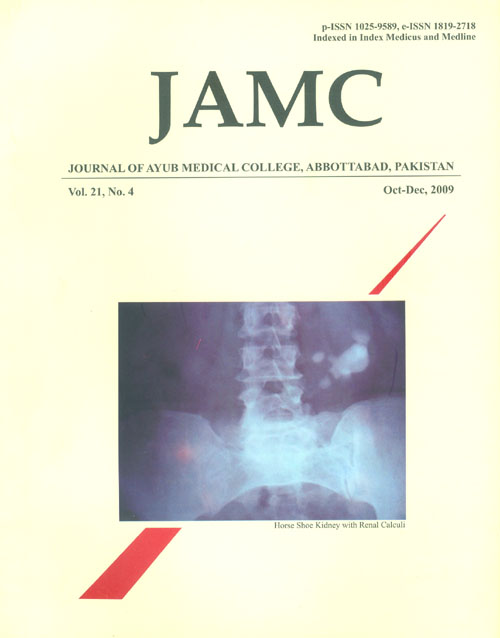PER-OPERATIVE FINDINGS OF BLOCKED VENTRICULOPERITONEAL SHUNT: A STUDY OF 72 CASES
Abstract
Background: Most patients with hydrocephalus are treated with ventriculo-peritoneal (VP) shuntplacement; however, malfunction is common and is usually caused by mechanical failure. The aim
of this study was to evaluate the per-operative findings accompanying presumed VP shunt
malfunction. Methods: This is a descriptive study of 72 patients operated for shunt malfunction in
the Department of Neurosurgery, Postgraduate Medical Institute, Lady Reading Hospital,
Peshawar from January to December 2008. Presenting symptoms and signs, clinical shunt
function, operative findings and outcome were recorded. Results: Common presenting features
were vomiting, irritability and general toxic look of patients. Male to female ratio was 3:1. Upper
end block was observed in 39 patients while lower end and reservoir block was noted in 13 and 2
patients respectively. Choroids plexus was found in 29.2% of cases with upper end block, shunt
revision was performed in most of cases (80.6%). Conclusion: The importance of clinical features
cannot be overlooked in a patient with shunt malfunction. Upper end block due to choroids plexus
is common operative finding.
Keywords: VP shunt, shunt malfunction, choroid plexus
References
Goeser CD, Mcleary MS, Young LW. Diagnostic imaging of
ventriculoperotoneal shunt malfunctions and complications.
Scientific Exhibit 1998;18:635-51.
Iskandar BJ, Mclaughlin C, Mapstone TB, Grabb PA, Oakes
WJ. Pitfalls in the diagnosis of ventricular shunt dysfunction;
radiology reports and ventricular size. Pediatrics
;101:1031-6.
Sacar S, Turqut H, Toprak S, Cirak B, Coskon E, Yilmaz O,
et al. A retrospective study of central nervous system shunt
infections diagnosed in a university hospital during a 4-years
period. BMC Infect Dis 2006;6:43-7.
Somadani AF, Storm PB, Kuchner EB, Garonzik IM,
Sciubba D, Carson B. Ventriculoperitoneal shunt malfunction
presenting with pleuritic chest pain. Pediatr Emerg Care
;21:261-3.
Lee TT, Uribe J, Ragheb J, Morrison G, Jagid JR. Unique
clinical presentation of pediatric shunt malfunction. Pediatr
Neurosurg 1999;30:122-6.
Bhatnagar V, George J, Mitra DK, Upadhyaya P.
Complications of cerebrospinal fluid shunts. Indian J Pediatr
;50:133-8.
Kaufman BA, Mclone DG. Infection of cerebrospinal fluid
shunts In: Scheld WM, Whitley RJ, Durack DT editors.
Infection of the central nervous system. New York: Raven
press; 1991. p. 561-85.
Morrice JJ, Young DG. Bacterial colonization of Holter
valves: A ten years survey. Dev Med Child Neurol
;16:85-90.
Olsen L, Fryberg T. Complications in the treatment of
hydrocephalus in children. Acta Pediatr Scand 1983;72:385-90.
Schoenbaum SC, Gardener P, Shillito J. Infections of the
cerebrospinal fluid shunts; epidemiology, clinical
manifestations and therapy. J Infect Dis 1975;131:543-52.
Sainte-Rose C, Piatt JH, Renier D, Pierre-Kahn A, Hirsch JF,
Hoffman HJ, et al. Mechanical complications in shunts.
Pediatr Neurosurg 1991-92;17:2-9.
Lazareff JA, Peacock W, Holly L, Ver Halen J, Wong A,
Olmstead C, et al. Multiple shunt failures: an analysis of
relevant factors. Childs Nerv Syst1998;14:271-5.
Barnes NP, Jones SJ, Hayward RD, Harkness WJ, Thompson D.
Ventriculoperitoneal shunt block: what are the best predictive
clinical indicators? Arch Dis Child 2002;87:198-201.
Downloads
Published
How to Cite
Issue
Section
License
Journal of Ayub Medical College, Abbottabad is an OPEN ACCESS JOURNAL which means that all content is FREELY available without charge to all users whether registered with the journal or not. The work published by J Ayub Med Coll Abbottabad is licensed and distributed under the creative commons License CC BY ND Attribution-NoDerivs. Material printed in this journal is OPEN to access, and are FREE for use in academic and research work with proper citation. J Ayub Med Coll Abbottabad accepts only original material for publication with the understanding that except for abstracts, no part of the data has been published or will be submitted for publication elsewhere before appearing in J Ayub Med Coll Abbottabad. The Editorial Board of J Ayub Med Coll Abbottabad makes every effort to ensure the accuracy and authenticity of material printed in J Ayub Med Coll Abbottabad. However, conclusions and statements expressed are views of the authors and do not reflect the opinion/policy of J Ayub Med Coll Abbottabad or the Editorial Board.
USERS are allowed to read, download, copy, distribute, print, search, or link to the full texts of the articles, or use them for any other lawful purpose, without asking prior permission from the publisher or the author. This is in accordance with the BOAI definition of open access.
AUTHORS retain the rights of free downloading/unlimited e-print of full text and sharing/disseminating the article without any restriction, by any means including twitter, scholarly collaboration networks such as ResearchGate, Academia.eu, and social media sites such as Twitter, LinkedIn, Google Scholar and any other professional or academic networking site.










